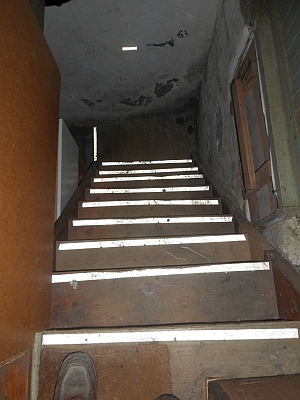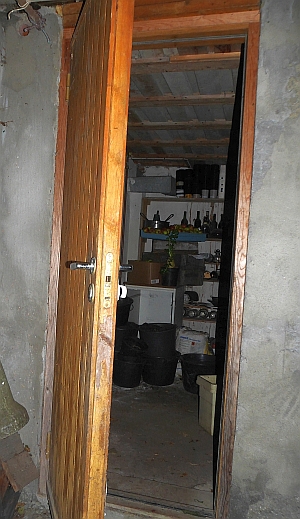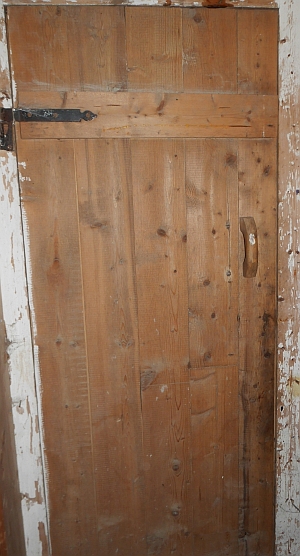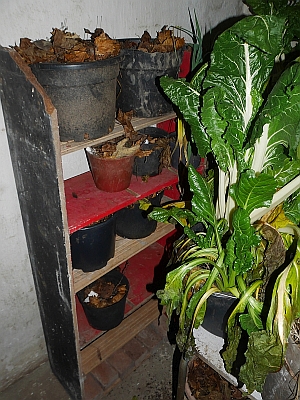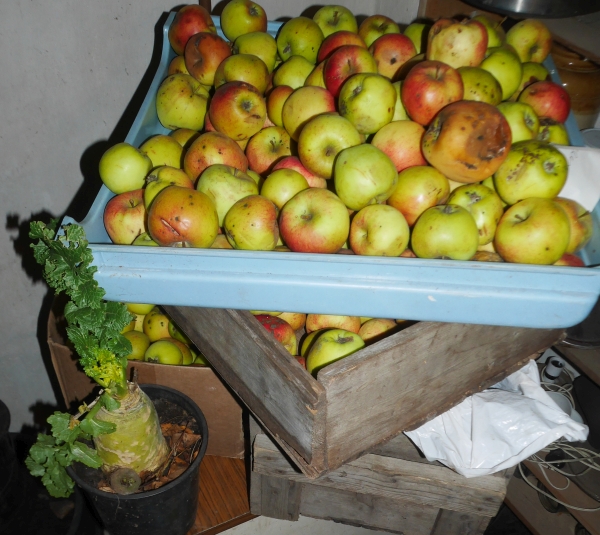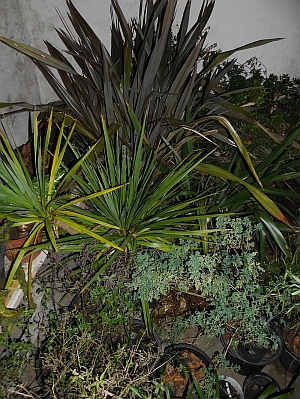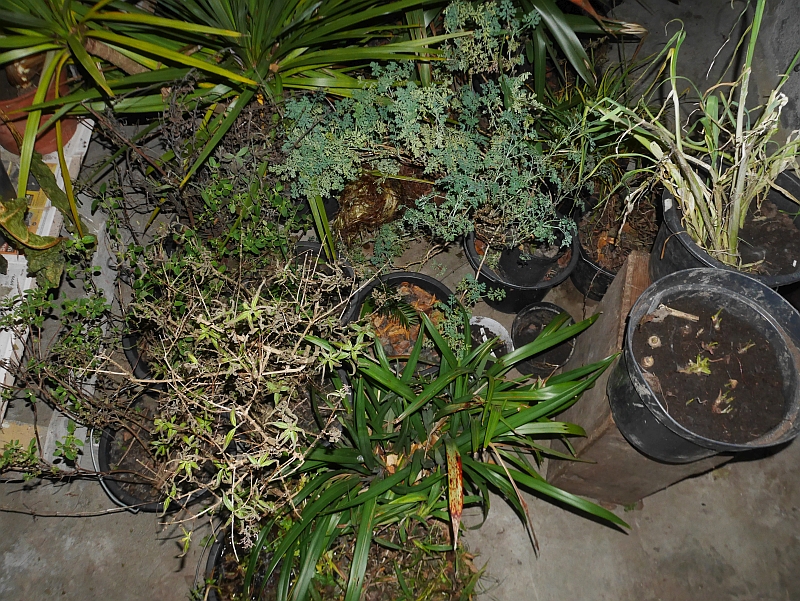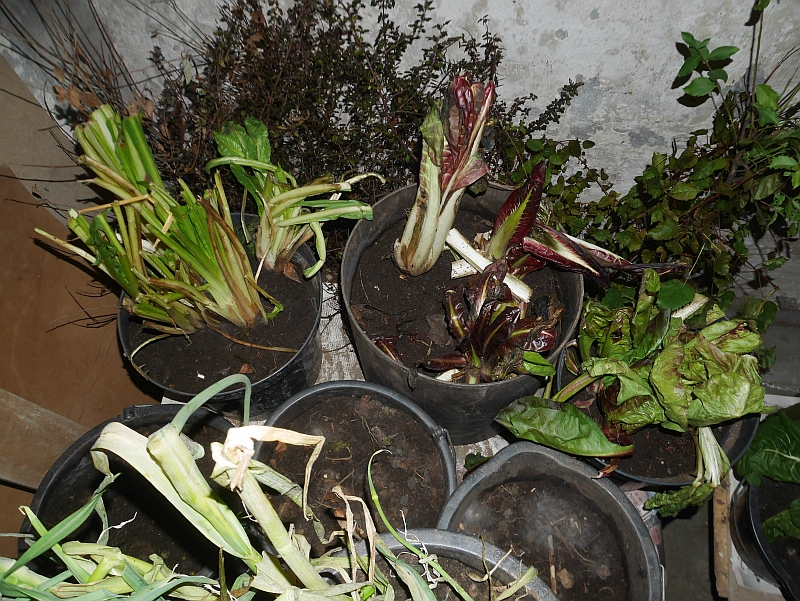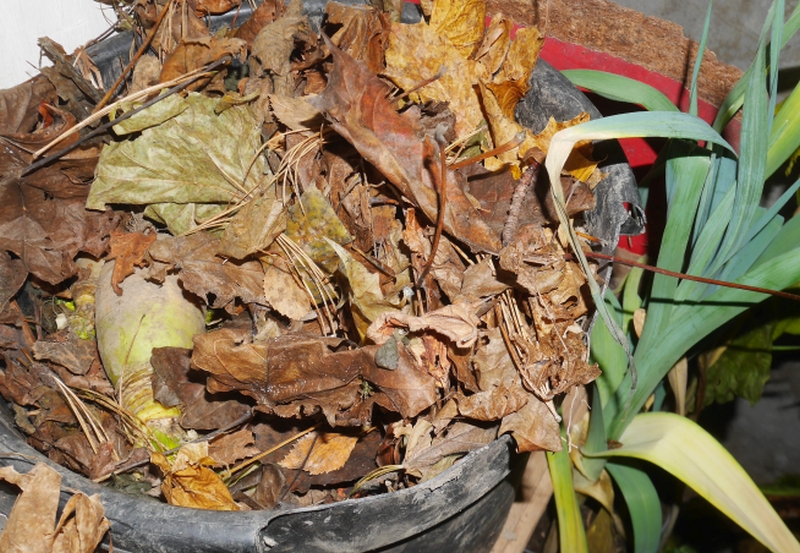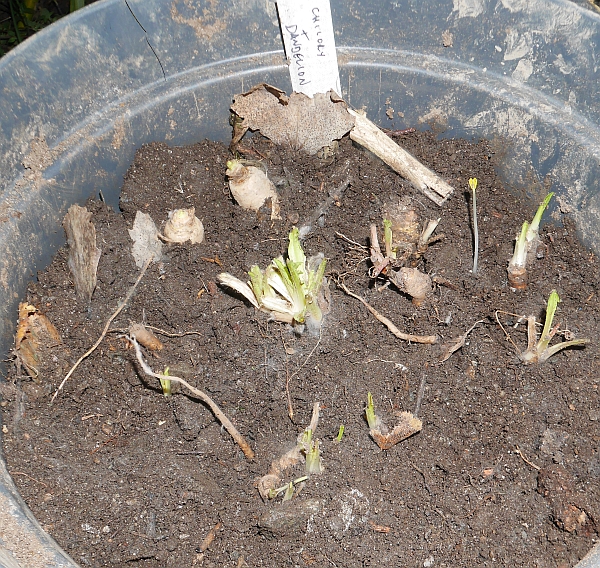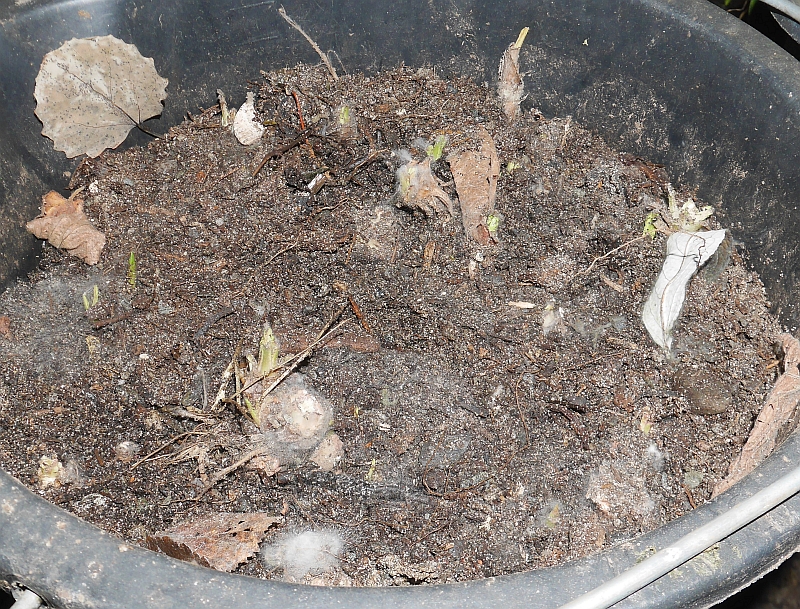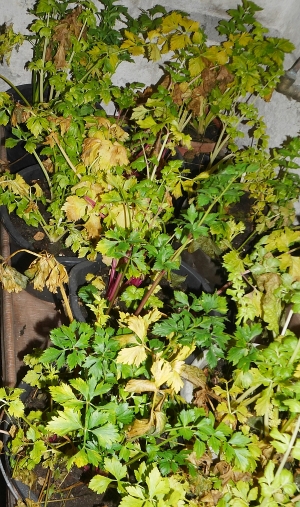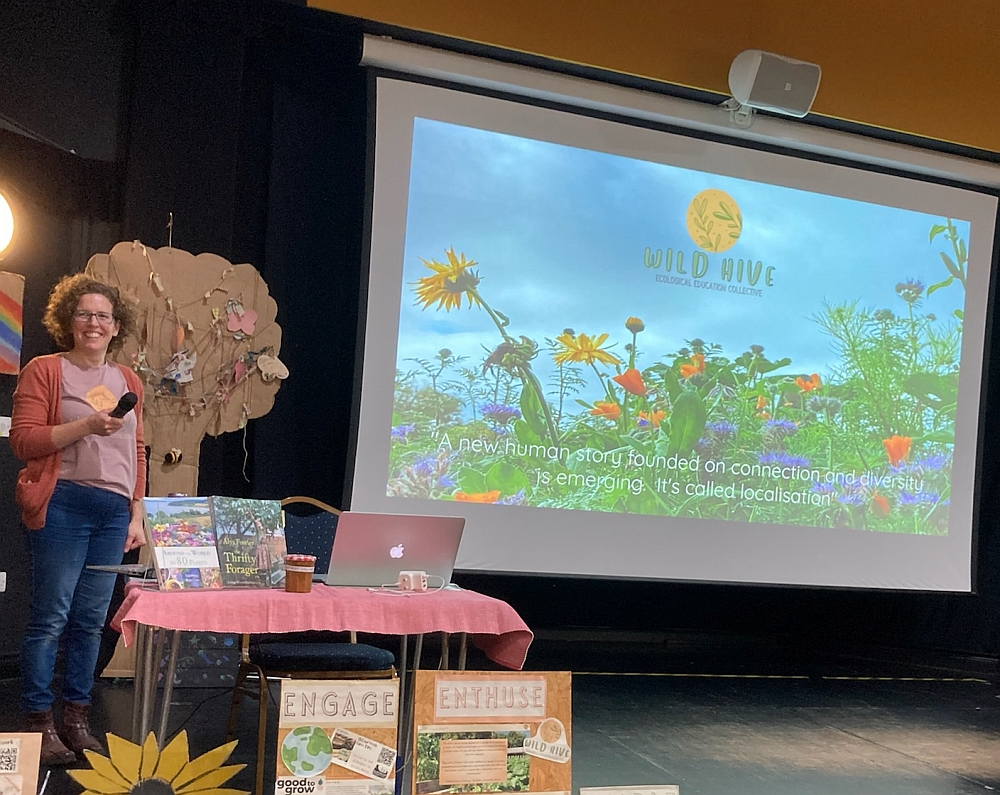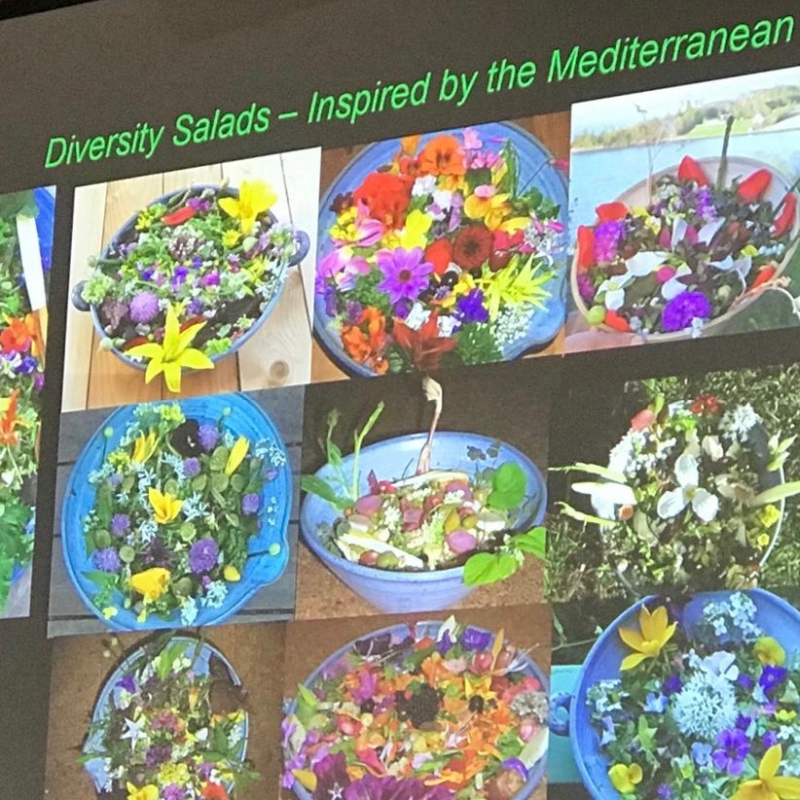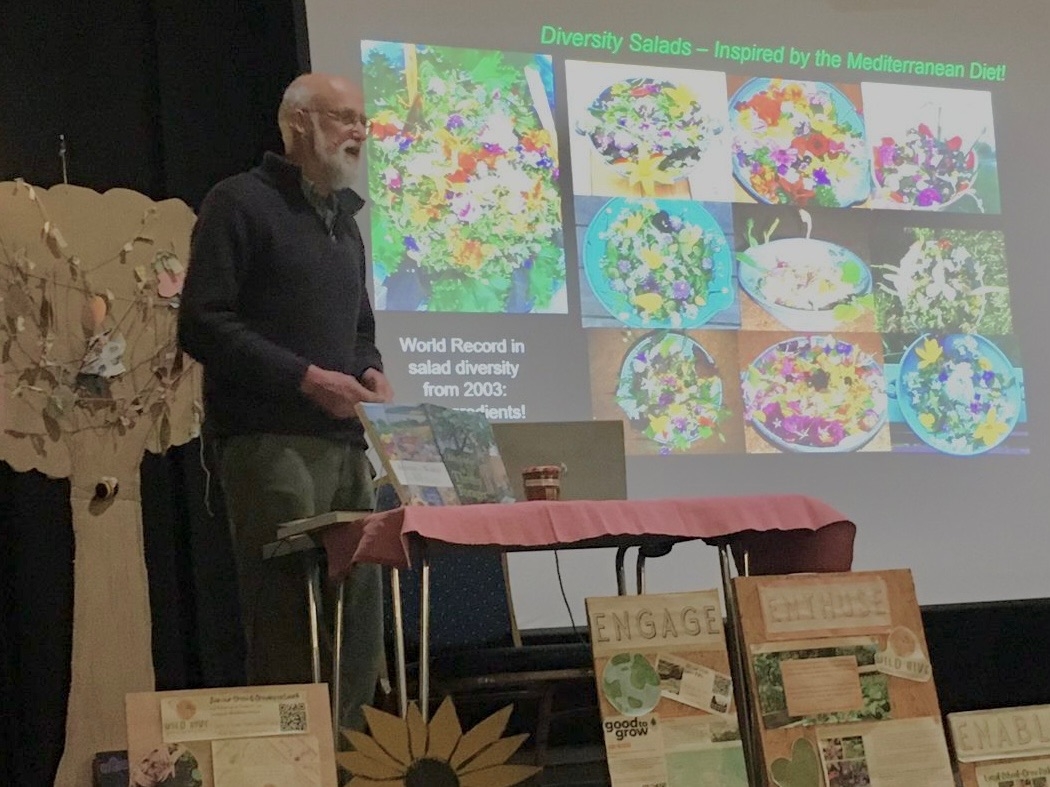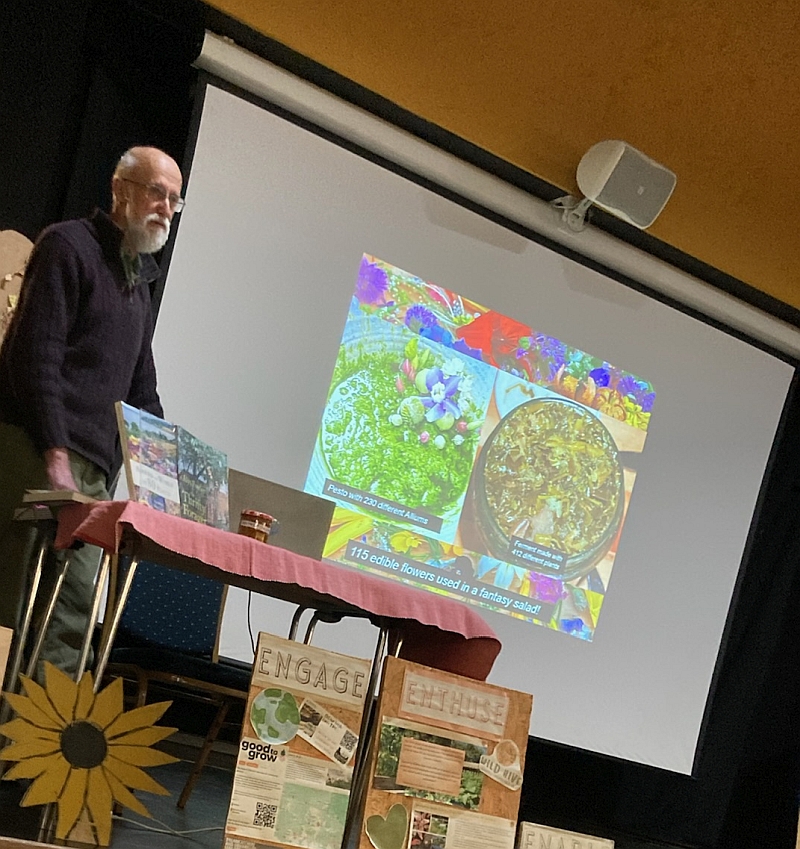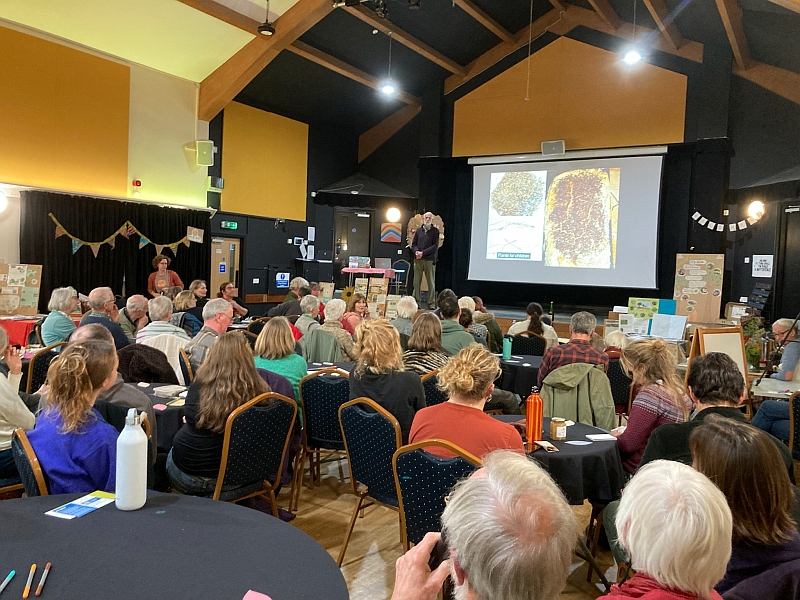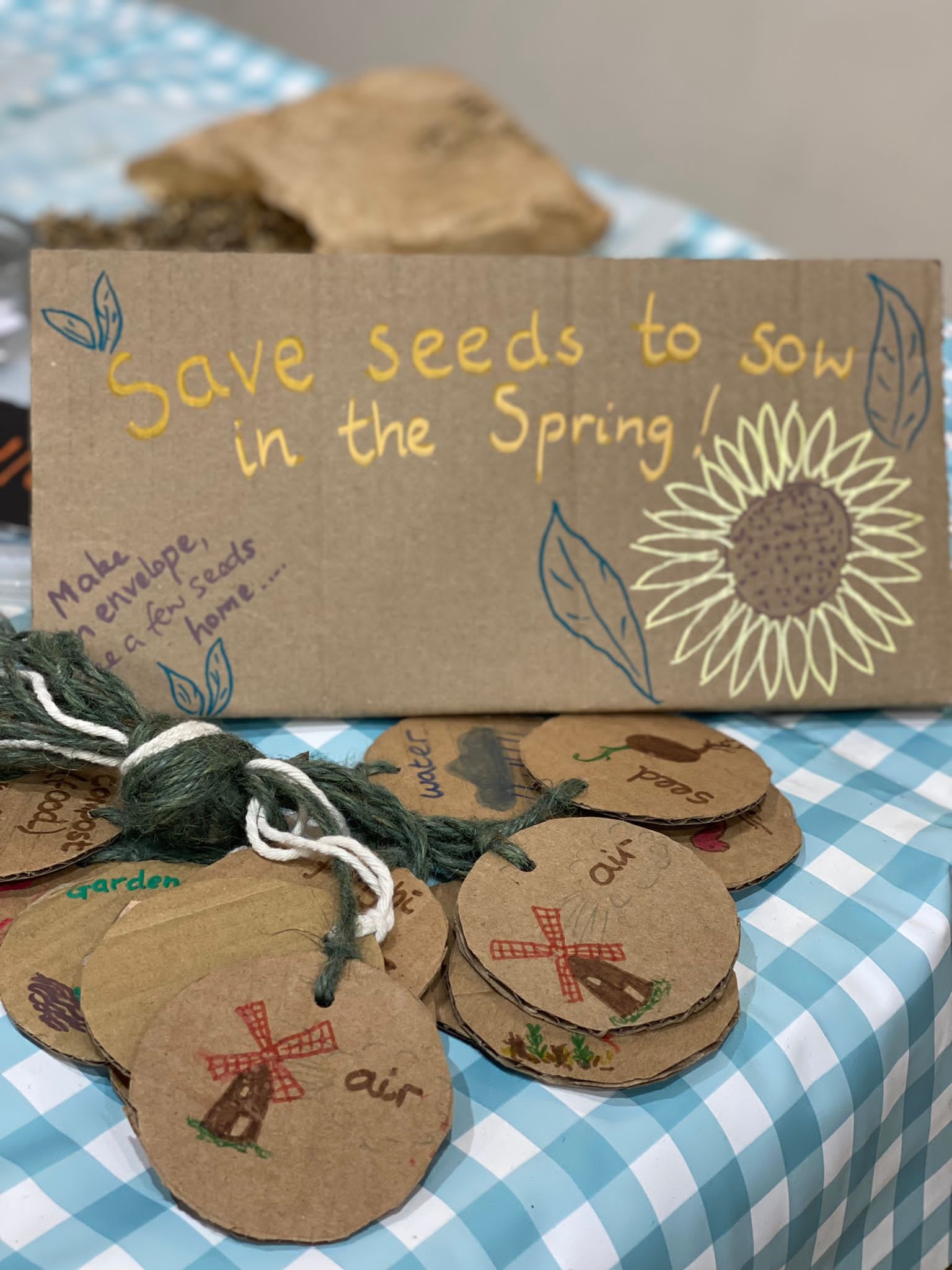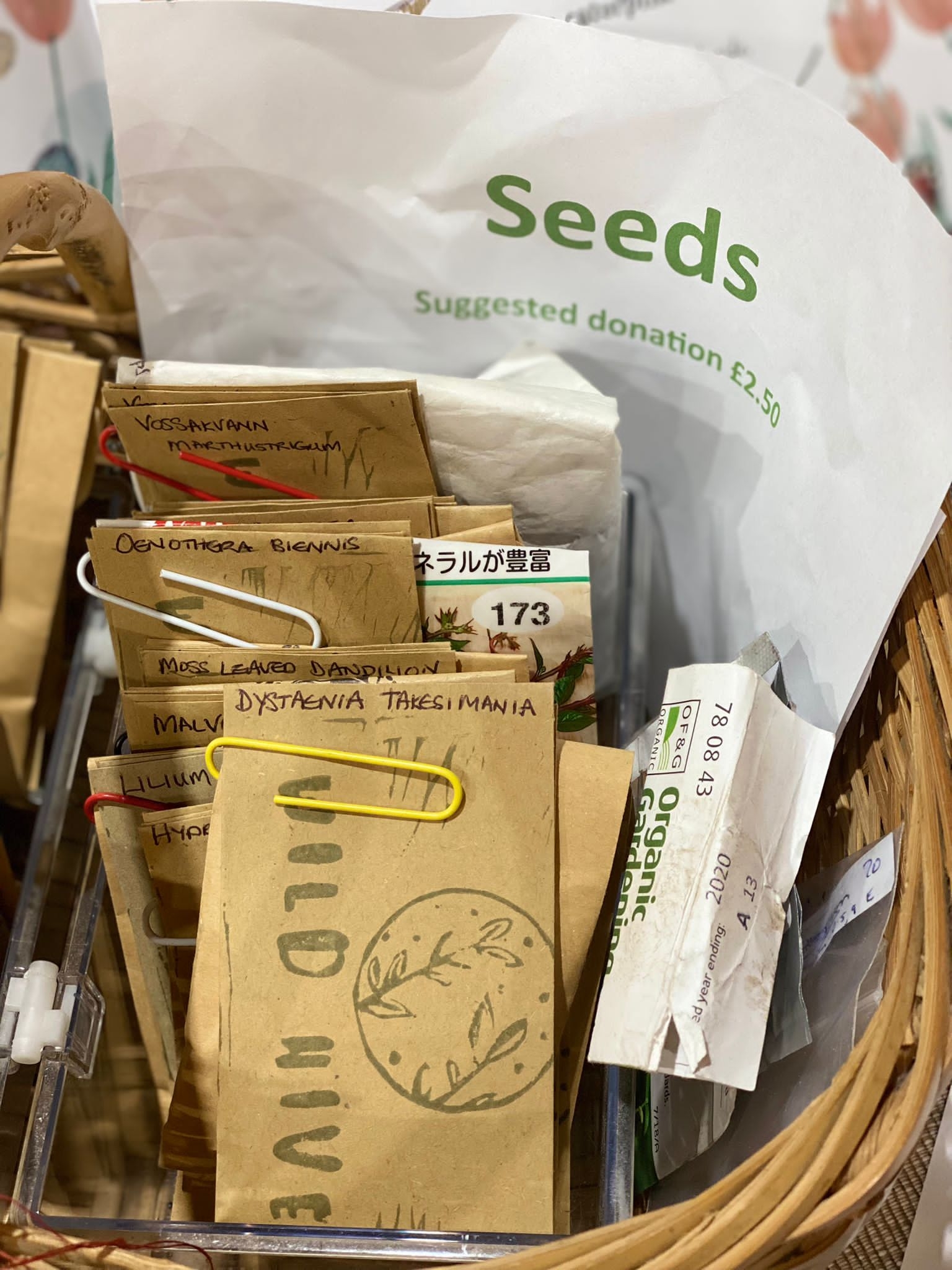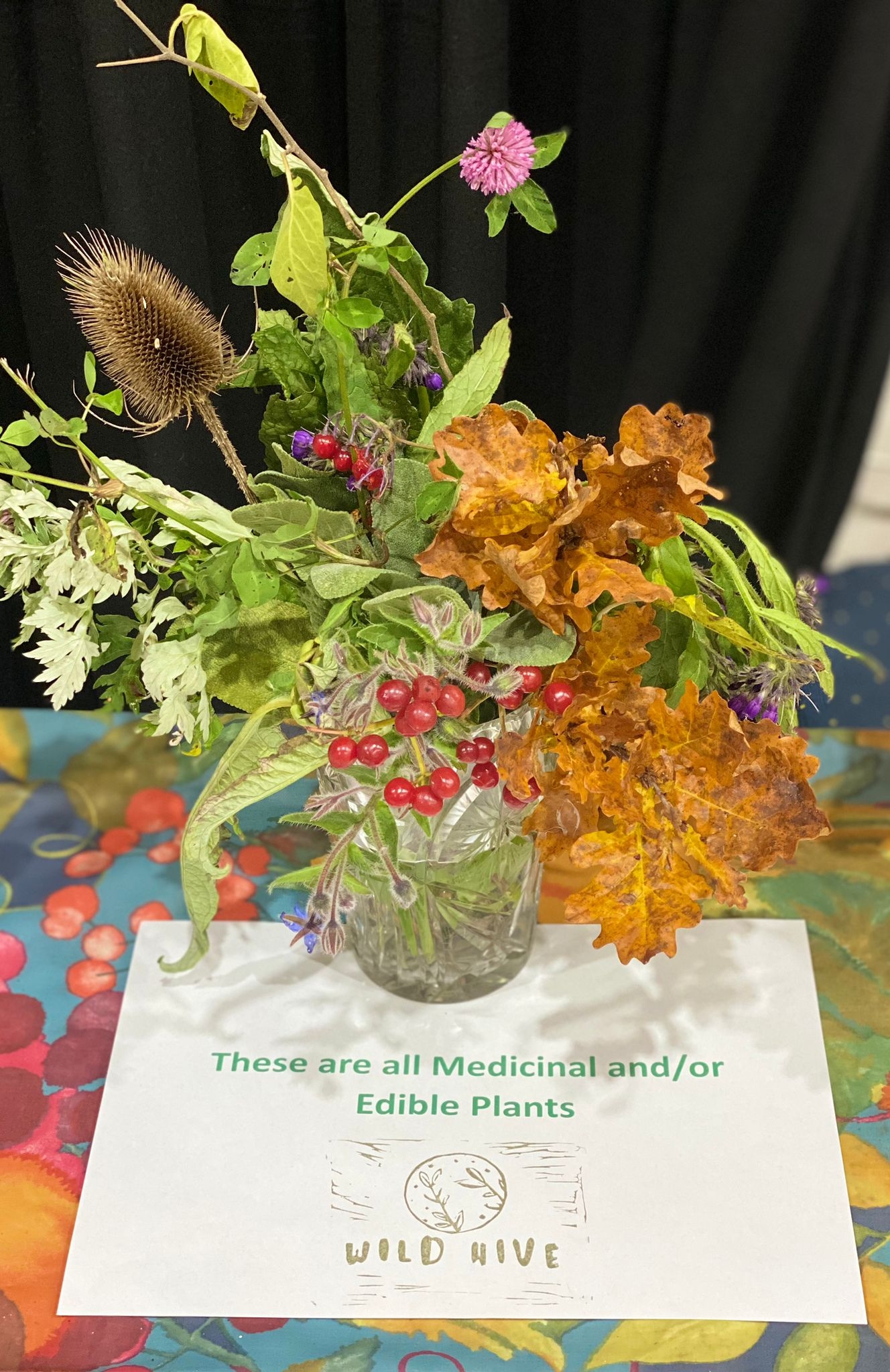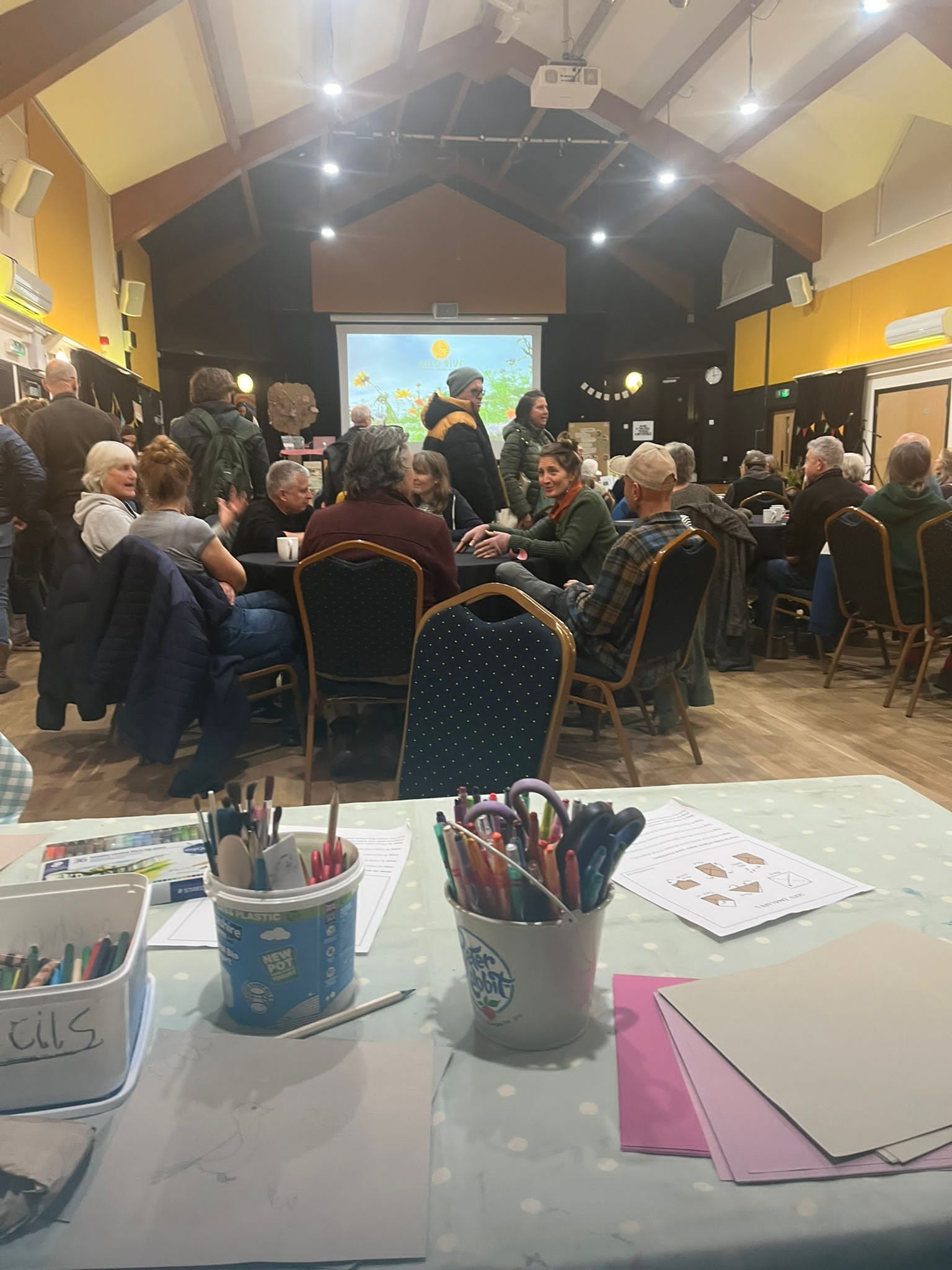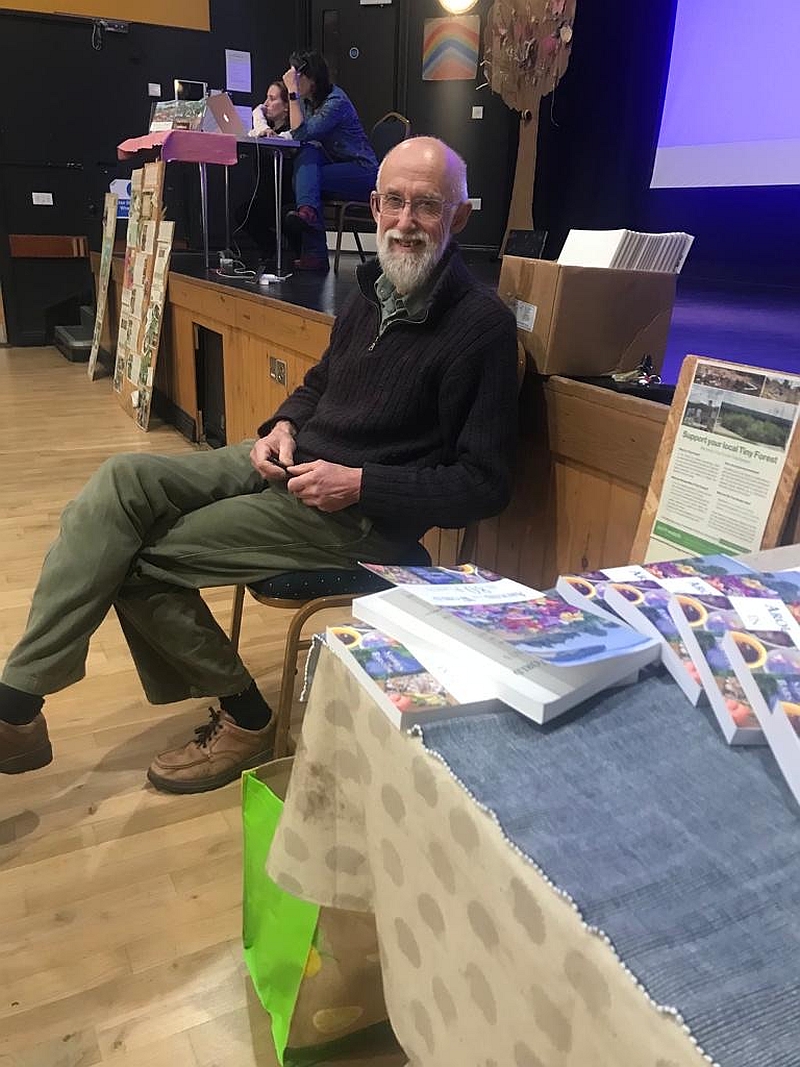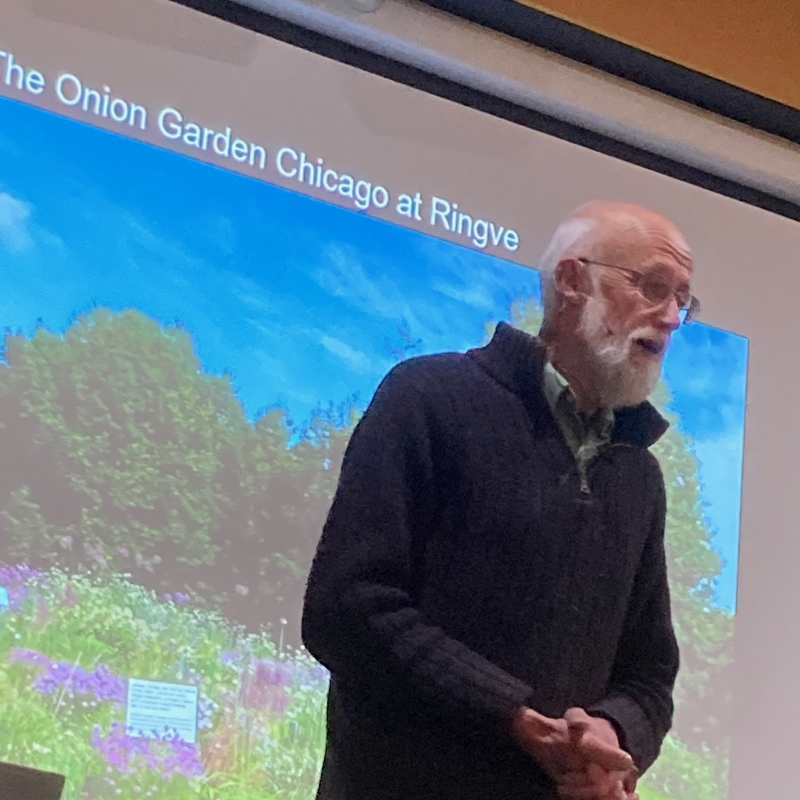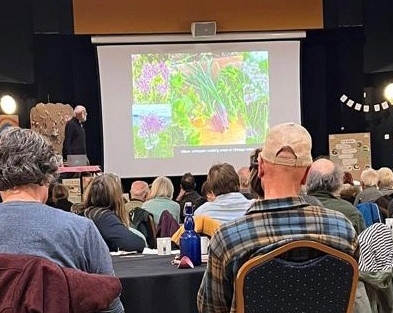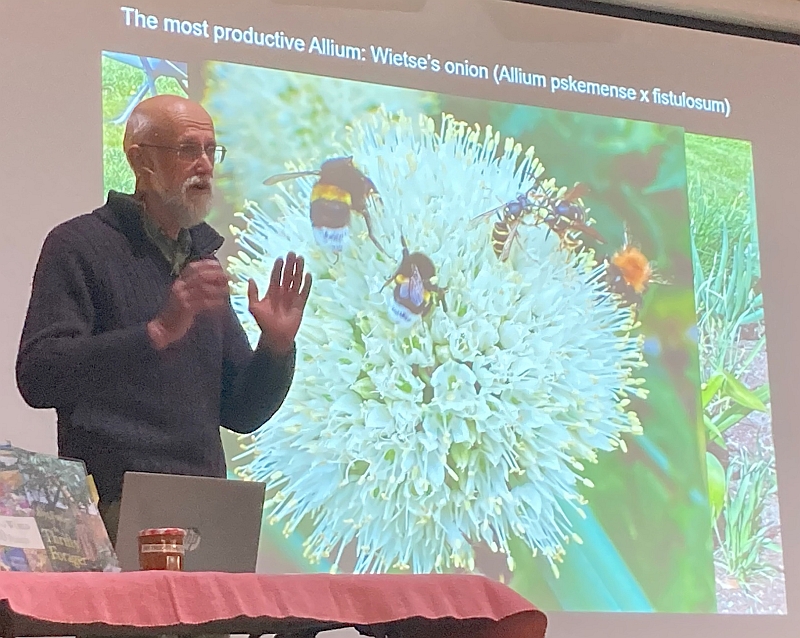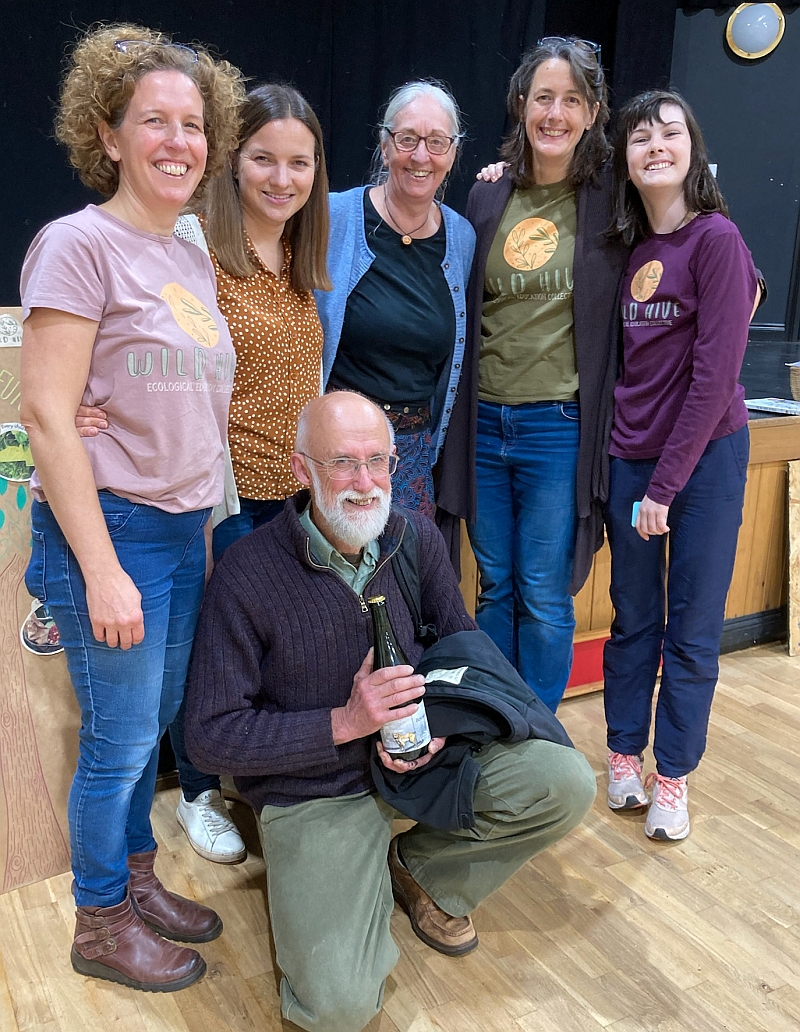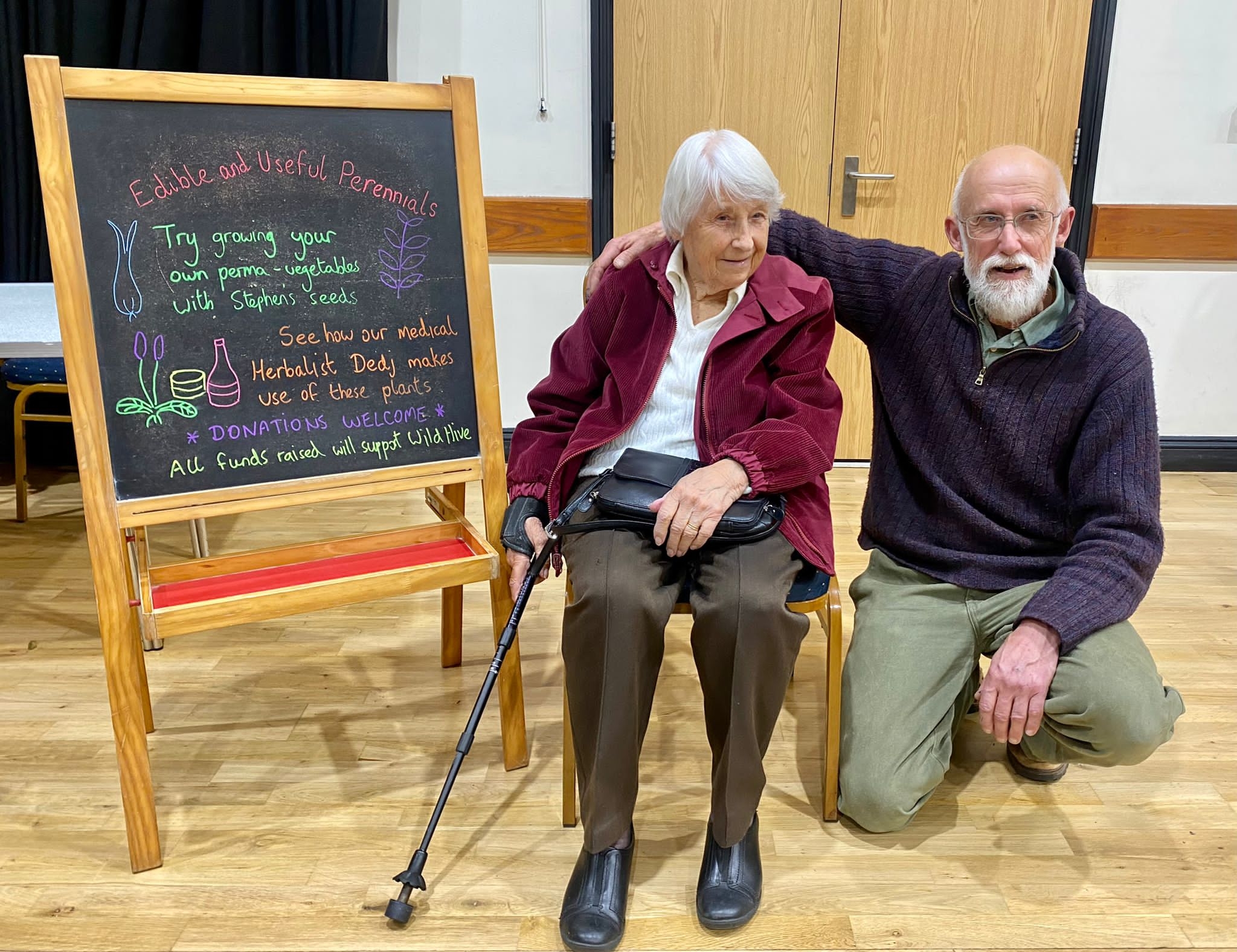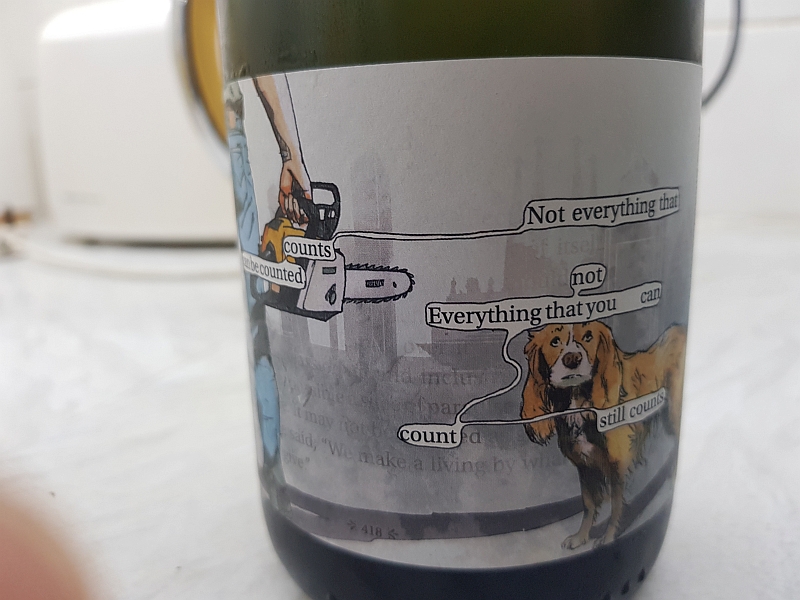Last night’s simple winter omelette with ingredients I had on hand:
Wapato tubers (Sagittaria latifolia)
Potato “Blue Congo”
Swiss chard (mangold)
Shallots “Finland” (an old Finnish / Norwegian variety of sjalott)
Barberry (vill berberis) fruits – see https://www.edimentals.com/blog/?p=27761
Tomatoes / tomat (some of the last fruits)
Salt, pepper and chili
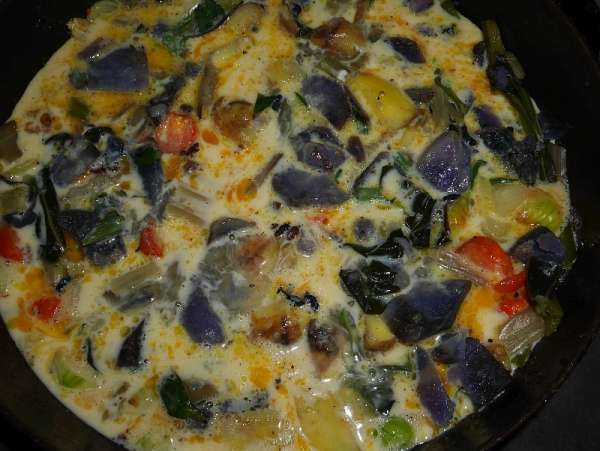
All posts by Stephen Barstow
A tour of the Edible House cellar!
I probably wasn’t aware, when we bought the house 40 years ago next year, how important the cold cellar under the house would be. It is largely unimproved since we moved here. It has allowed us to be self-sufficient in all our own fresh vegetables, root crops and fruit with minimal pre-processing. There are 4 full size rooms in the cellar which are kept dark (there are small windows which are kept covered) and without heating. Even though it is relatively early in the winter, it is at the moment just about as cold as it ever gets down there thanks to the freezing temperatures since the end of October. First are some pictures of the stairs and doors. Below is another album of pictures of the vegetables in storage; explanation with the pictures!
Fuglevennlige planter
English: A series of 3 articles written for Birdlife Norway’s magazine “Vår Fuglefauna”
Wild Hive Talk at Home in Chandlers Ford: Resonating with Hampshire!
Thank you once again to all the amazing Wild Hive Collective team for organizing my talk in Chandlers Ford, my home town, on 19th November 2023. It attracted a full house of some 80 people plus helpers. See their review here: Wild Hive Collective Review
This was a special event for me being the first time I’d talked outside of Norway since Covid and dedicated to my dad (Harold G Barstow) who died last year at 97 and possibly the vegetable grower who had been at it longest in the area, here with his broad beans at 90, in a raised bed he made in his 80s, planning for old age: 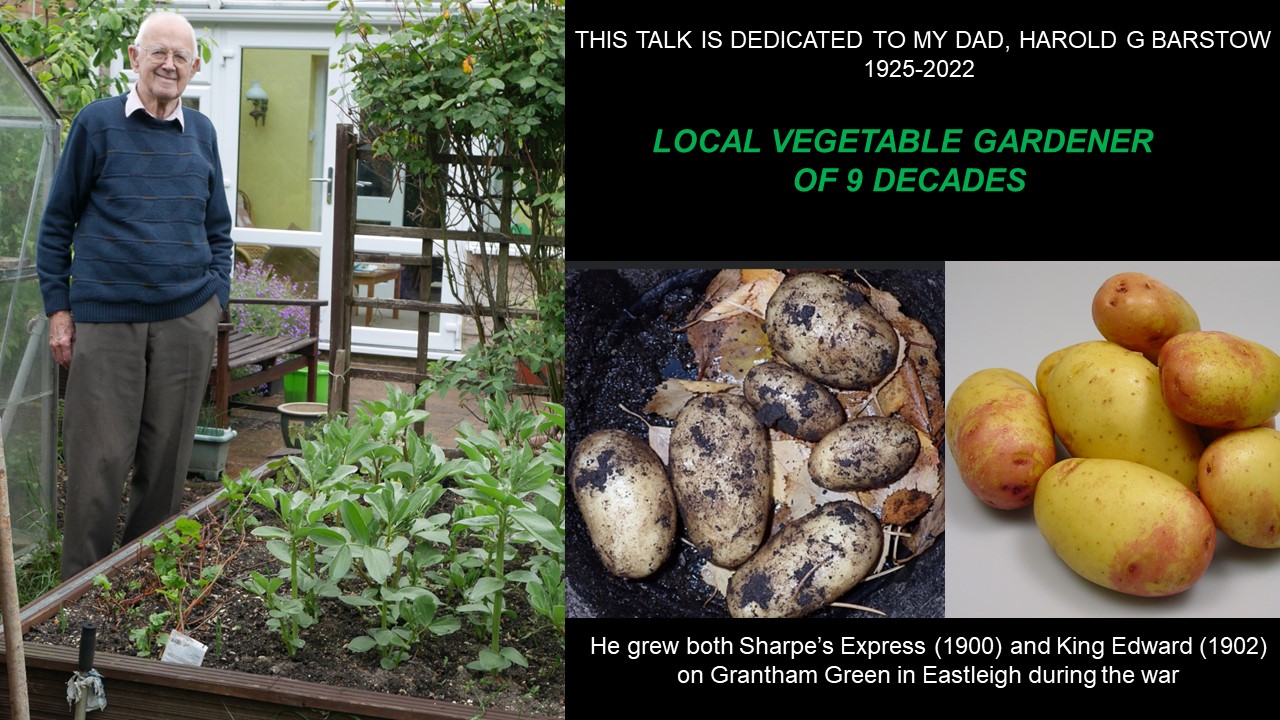 Dad had worked as a joiner/carpenter all is life (his parents couldn’t afford to give him an education and he left school early). He became an expert on Great Britain Victorian stamps (where I get my collectomanic genes from). On retirement he spent his time well, researching local history and publishing 8 or 9 books on the subject, involving learning medieval latin. He also became an artist, painting old local buildings. He wrote 4 books about the North Stoneham area where his grandfather had repaired the one-handed clock at North Stoneham (he’s pointing to him in the picture on the wall of the Cricketers Pub and he can also be seen standing with his bike in front of the church on the front of one of the books):
Dad had worked as a joiner/carpenter all is life (his parents couldn’t afford to give him an education and he left school early). He became an expert on Great Britain Victorian stamps (where I get my collectomanic genes from). On retirement he spent his time well, researching local history and publishing 8 or 9 books on the subject, involving learning medieval latin. He also became an artist, painting old local buildings. He wrote 4 books about the North Stoneham area where his grandfather had repaired the one-handed clock at North Stoneham (he’s pointing to him in the picture on the wall of the Cricketers Pub and he can also be seen standing with his bike in front of the church on the front of one of the books):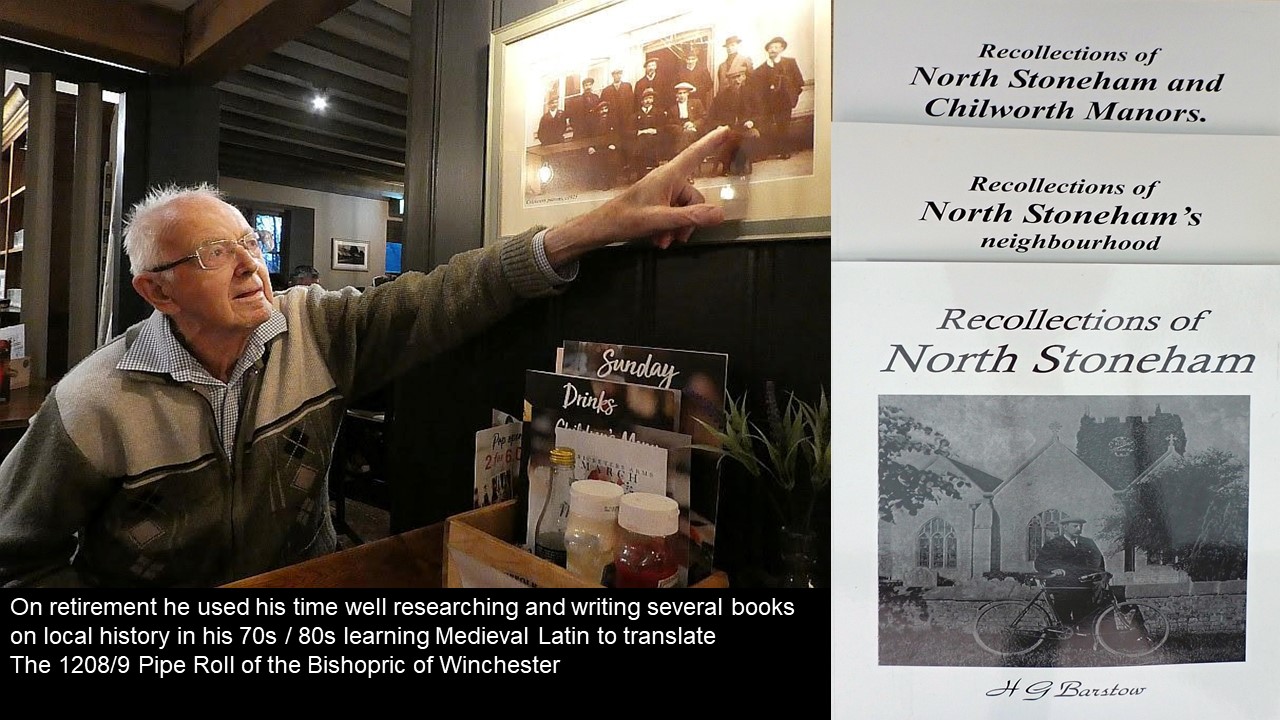 …..and not forgetting my dear mum Patricia (Pat) Barstow (soon 94) who was in the audience:
…..and not forgetting my dear mum Patricia (Pat) Barstow (soon 94) who was in the audience:
The first part of my talk was all about perennial vegetables and Hampshire and all the wonderful interconnections with my family and others I’ve experienced there over the years!
In 2015, I was invited to give a two-part talk at the Walled Kitchen Gardens Network Forum at National Trust property Croome Court in Worcestershire and I discovered that two of my family were already well known and respected in that eminent group! At dinner on the first night in Pershore, it dawned on the people there that I also was the son of the “famous” North Stoneham historian and author and when it was revealed that author of the book “Garden archaeology”, Christopher Currie was my cousin, who excavated the North Stoneham site, then I was well and truly one of them!! For there is a strong link as Capability Brown (who designed Croome’s gardens) was almost certainly also responsible for North Stoneham. Several of those at dinner that night were from Hampshire and campaigning to save the North Stoneham site!! Small world and resonating with the cosmos once again…………. It was the chairwoman of the forum, Susan Campbell, one of the most knowledgeable people in the land on kitchen gardening and edible plants who had invited me to Croome, having read my book. She had thought I was Norwegian until we met. She and her husband Mike have a fantastic beachside property in Hampshire where I visited a year or so after Croome. The title of her book “Charleston Kedding: A History of Kitchen Gardening” is one of the most original book titles. Charleston Kedding is a fictional place around which the book is based, the name being an anagram for Old Kitchen Gardens!
It was the chairwoman of the forum, Susan Campbell, one of the most knowledgeable people in the land on kitchen gardening and edible plants who had invited me to Croome, having read my book. She had thought I was Norwegian until we met. She and her husband Mike have a fantastic beachside property in Hampshire where I visited a year or so after Croome. The title of her book “Charleston Kedding: A History of Kitchen Gardening” is one of the most original book titles. Charleston Kedding is a fictional place around which the book is based, the name being an anagram for Old Kitchen Gardens! 

The following year was the 300th anniversary of Capability Brown’s birth:
See more pictures from Croome here https://www.edimentals.com/blog/?page_id=2554
It was at Croome I talked about Hostas, jokeing as I did in my original article on “The Oriental Spinach” in Permaculture Magazine, about Prince Charles having the most productive forest garden in the UK as he had a national collection of large-leaved Hostas in a woodland area at Highgrove, not knowing that the Prince’s head gardener sat in front of me. I later signed a copy of my book “To HRH Prince Charles, good luck with your Hosta cuisine” asking them to pass on to the prince. This lead the following year to being invited to Highgrove to see the collection…sadly, the Prince didn’t turn up as it was his mum’s birthday….priorities!
I next introduced a good ex-pat friend in Norway, David Woodland, who had attended a talk I gave in Bergen over 10 years ago now. I had mentioned during that talk I was from Hampshire and afterwards he asked where. I said Eastleigh and he then told me he grow up only a mile or so away in Colden Common! We had been growing veg in Norway for as long as one another! David’s father was Dennis Woodland who did most of the work and took pictures for the Hillier Manual of Trees and Shrubs in the 70s. David’s family lived for some time at Jermyn’s House at the Hillier Gardens, just 6 miles from where my family have lived since the early 70s in Chandlers Ford. On the back of an interview I did with Radio Solent in Southampton soon after the book came out, I was invited to give a walk and talk at Hilliers in 2015 and the talk was in Jermyn’s House! This was the first of several walks and talks I did all over the world in botanical gardens and at Hilliers I was allowed for the first time to pick from the ornamental borders for a lunch salad! Mum and Dad attended (Dad can be seen in the background in the second picture below)!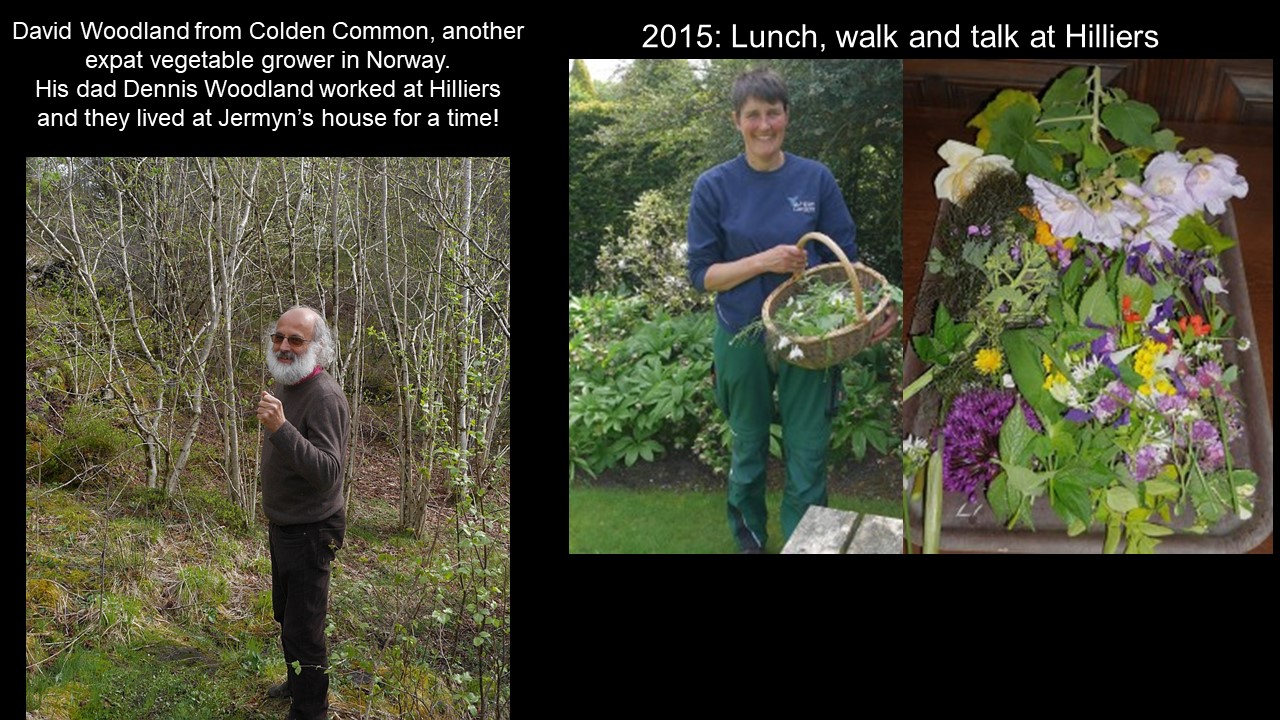
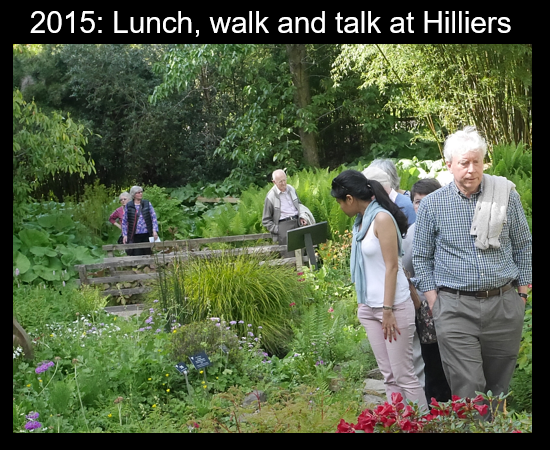 See another blog post on the Hilliers walk and talk here: https://www.edimentals.com/blog/?page_id=1281
See another blog post on the Hilliers walk and talk here: https://www.edimentals.com/blog/?page_id=1281
The next interconnection happened at that Hillier talk. As I was in Hampshire I talked about what I call the Hampshire perennial vegetable triangle where both Sea Kale (the most British of all vegetables), through William Curtis in Alton and Gilbert White in Selbourne, and watercress (Alresford) were domesticated in the 17-1800s: 
Little did I know but Sheila John, a volunteer at the Curtis Museum in Alton, was in the audience at Jermyn’s House. After the talk, Sheila approached me and asked if I would give my talk in Alton which I did a couple of years later in the Allen Gallery where, in the back garden they were planning a garden of William Curtis plants. I spent the next day in the library of the museum which had several rare books on Curtis. Sheila had also in the meantine helped me get a copy of his pamphlet on sea kale (below) from the British Museum:


….and this takes me back to garden historian Susan Campbell who I visited in 2017 at her home on the Solent, where she had a small sea kale garden next to the beach supplying sea kale to a restaurant in London (in season). At that time, she was the only one growing this wonderful vegetable for sale; see more at https://www.edimentals.com/blog/?p=10713
The same day I had visited another of the speakers at Croome, Tim Phillips who has a wonderful vineyard within a walled garden near Susan in Lymington, see https://www.edimentals.com/blog/?p=10678
I was happy to spot Tim in the audience for the Chandlers Ford talk….thanks for the bottle Tim (pictures in the gallery at the bottom)!
I can mention a few more connections to finish. In April 2008, I was with mum in the Hillier gardens and we’d stopped to admire some rather colourful purple spring shoots of a Hosta, possibly the cultivar “Patriot” (picture below). At that time I was writing my article for Permaculture Magazine on “Hosta: The Oriental Perennial Spinach” and was looking for ones with “edimental” shoots (a word I “invented” at about that time). At that moment a familiar face comes striding down the hill towards us with a group. It was well known plantsman, gardener, author and broadcaster, Roy Lancaster who has long been associated with Hilliers and I knew he lived locally in Chandlers Ford. He stopped for a chat and we talked for about 15 minutes about the edibility of Hostas and other unusual edibles Roy had come across on his travels. Below are those Hosta shoots and Roy disappearing up the path having lost the party he had been with!

 Roy’s plant exploring writing had always been an inspiration for me, having read his book A Plantsman in Nepal in the 80s! It was to be over 15 years before we should meet again as he was in the audience at my talk, invited by Wild Hive’s Lizzie Dunn who is in his family. I was hoping he would come as my friend David Woodland (above) had known him when his dad was working at Hilliers and had sent a greeting to Roy which I passed on when I saw him react to the slide of David I showed! Roy told me that they hadn’t met since he had left for Norway! Roy came up afterwards to tell me that he had enjoyed the talk and encouraged me to keep it up….wow!
Roy’s plant exploring writing had always been an inspiration for me, having read his book A Plantsman in Nepal in the 80s! It was to be over 15 years before we should meet again as he was in the audience at my talk, invited by Wild Hive’s Lizzie Dunn who is in his family. I was hoping he would come as my friend David Woodland (above) had known him when his dad was working at Hilliers and had sent a greeting to Roy which I passed on when I saw him react to the slide of David I showed! Roy told me that they hadn’t met since he had left for Norway! Roy came up afterwards to tell me that he had enjoyed the talk and encouraged me to keep it up….wow!
Incidentally, I grow one of Roy’s introductions from Nepal, a lovely form of Allium wallichii which I call “Lancaster”. It can be seen in the Onion Garden Chicago in Trondheim that I look after! Long hoverfly on Allium wallichii “Lancaster” at the Ringve Botanical Gardens
Long hoverfly on Allium wallichii “Lancaster” at the Ringve Botanical Gardens
I was also very happy to see Jen Butcher from Nottingham at the talk. She had stayed with us in Norway for a week on an RHS bursary in May and brought along two others from RHS Wisley! Another long traveller was Chris Seagon and his wife who had travelled down from Lincolnshire. They have relocated their Devon Edible Garden Nursery there!
The final connection is a special thanks to Nic Landsdowne and her husband Richard who run the venue at the Hilt in Chandlers Ford. It was also Nic, who is one of my mum’s helpers who suggested earlier in the year that I should be in touch with Wild Hive….thank you, Nic, this wouldn’t have happened without you!
…and what a lovely review of my talk event by Wild Hive (follow the link below and help them if you can, what they are doing is incredibly important!). Through the amount of work and promotion the Wild Hive – Ecological Education Collective crew put in to this, they thoroughly the fundrasing success it was!
https://www.wildhivecollective.org.uk/post/extreme-salad-man-stephen-barstow-talks-on-home-turf-in-hampshire
The talk was filmed, so will hopefully be made available at some stage!
Seed offered at the talk:
See https://www.edimentals.com/blog/?p=31661
Below are a collection of pictures taken by Wild Hive on the day (unless stated). Thanks all…and I’ll hopefully be back for more in the spring!

Free temporary access to my book and articles!
Thanks to my publishers Permanent Publications and Permaculture Magazine, free browsing access is available until Thursday to both my book Around the World in 80 plants, two articles I wrote for the magazine on Hablitzia (the Caucasian Spinach) and Hosta (Oriental Spinach) as well as the current issue of the magazine! This is related to my talk tomorrow (Sunday) at the Hilt in Chandlers Ford (see more at https://www.tickettailor.com/events/hiltingburycommunityassociation/1043494)! Please consider subscribing to Permaculture Magazine!
Signed copies of the book can also be purchased from the author in Norway.
READING ROOMS access to
Around The World In 80 Plants:
https://delta.exacteditions.com/room/aroundtheworldin80plants/issue?Expires=1700750203&KeyId=eki_SCmNVK_BXtL6jBT5pB79pg&Signature=af330c3cc54ded5394321786f68e4653ec01e614
Permaculture Magazine Issue 52 (with my feature on Hablitzia):
https://delta.exacteditions.com/room/issue/permaculture/no52summer2007?Expires=1700750848&KeyId=eki__qmo_tE1uyPllYXLzdKPeQ&Signature=3a539b6fb0838d9a3d3f13246d93a25ff2458d8f
Permaculture Magazine Issue 83 (with my feature on Udo, Aralia cordata):
https://delta.exacteditions.com/room/issue/permaculture/no83spring2015?Expires=1700750817&KeyId=eki_B9S2HnkVYdIq-mFiherR3w&Signature=c51878e63e6533a09446fad9657ee20b3ea41456
Permaculture Magazine Issue 118 (the current issue):
https://delta.exacteditions.com/room/permaculture/issue?Expires=1700750013&KeyId=eki_xaPVsD8OQLOUo-N4lKnL-g&Signature=8507c6913aa8e30363d61d95d9d07b749fe68f16
Rare perennial veg seed on offer in Chandlers Ford
Below is a list of seeds of (mostly) perennial vegetables that will be offered at my talk at the Hilt in my home town of Chandlers Ford on Sunday 19th November 2023 (see more at https://www.tickettailor.com/events/hiltingburycommunityassociation/1043494). Income will go to Wild Hive who are organising the event!
Angelica archangelica ssp archangelica v. Majorum “Vossakvann Markusteigen”; garden Angelica: an old cultivated variety of mountain Angelica rescued from old farms in the Voss area of western Norway (self-seeds and dies after flowering); popular with many pollinators (see Around the World in 80 plants)
Allium victorialis “Eks-Røst”; victory onion: seed collected from plants in the Onion Garden Chicago in Trondheim, originally collected from a naturalized population on the island of Røst in the picturesque Lofoten Islands (could have crossed with other Allium victorialis plants in the garden. Popular with many pollinators (see Around the World in 80 plants) Naturalised Allium victorialis – Granvin, Norway
Naturalised Allium victorialis – Granvin, Norway
Phyteuma spicata; spiked rampion: edible roots, leaves and flower buds and very popular with pollinators. My article on these great plants can be downloaded here: https://www.edimentals.com/blog/?p=21018
Lilium martagon; Martagon lily: edible yellow bulbs and flowers. Great source of carbohydrates for the ground layer of a forest garden. See https://www.edimentals.com/blog/?p=8614
Allium hookeri var muliense; Yellow Hooker’s onion: Allium hookeri is grown on a food scale in China for the market. This is an edimental yellow flowered variety.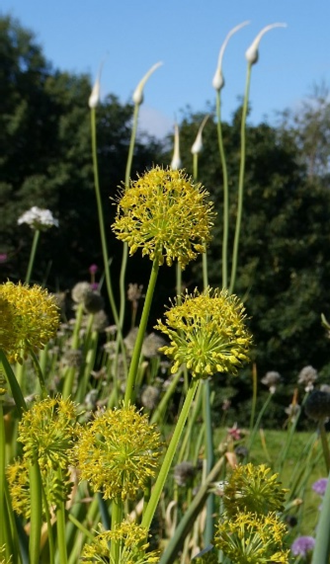
Allium hookeri var muliense
Hablitzia tamnoides; Caucasian spinach: this could well be my favourite perennial vegetable, long-lived, hardy, productive, shade loving and nutritious. Introduced by me through an article “Caucasian Spinach” in Permaculture Magazine in 2007! See Around the World in 80 plants and https://www.edimentals.com/blog/?page_id=1984. Hablitzia tamnoides
Hablitzia tamnoides
Allium stipitatum; Persian shallot is cultivated in a big way particularly in Iran and sold dried in Iranian supermarkets around the world. It is also one of the commonest ornamental onions sold each autumn (but, Alliums are often wrongly identified): a beautifully useful edimental! See https://www.edimentals.com/blog/?page_id=893 and other blog posts. Allium stipitatum, Persian shallots
Allium stipitatum, Persian shallots
Allium validum; Pacific onion. A traditional edimental from Western North America, important native American food plant (see Around the World in 80 plants)
Taraxacum tortilobum; the legendary moss-leaved dandelion: described in The Vegetable Garden (1920); see more about this great dandelion in Around the World in 80 plants.
Moss-leaved dandelion
Allium nutans Eks-Lena; a great Siberian onion with wide leaves, originally collected from a Siberian vegetable garden. Could have crossed with other Alliums in the Onion Garden Chicago in Trondheim. See more in Around the World in 80 plants.
Cryptotaenia japonica “Atropurpurea”; purple mitsuba is a popular Japanese herb/vegetable and interesting shade loving ground cover for a forest garden. See more in Around the World in 80 plants.
Allium fistulosum; Japanese welsh onion cultivar that has proved hardy. Originally purchased as a Japanese salad onion.
Agastache anisata “Aurea”; yellow anise hyssop
Brassica oleracea “Daubenton perennial kale x Late Purple Flowering Broccoli”; perennial kale hybrid (needs selecting for a dreamed of perennial purple flowering broccoli)
Dystaenia takesimana; giant Ulleung celery: A great new perennial vegetable, please read my article on this plant at https://www.edimentals.com/blog/?p=24998
Allium wallichii; Nepal or Sherpa onion: a spectacular edimental onion from the Himalaya – the dried leaves are an important vegetable (dried for market at high elevations)
Allium wallichii
Oenothera biennis; evening primrose: A great biannual edimental which self-sows – all parts are edible. Try the seeds as a topping on bread and baked dishes.
Malva moschata; musk mallow: the leaves are great in salads, stir-fries and soups and are provided in smaller amounts throughout the season. Flowers are used to decorate salads!
Allium macranthum; chiugok or small bird’s garlic is another great edimental from the Himalaya. See my article on this plant’s ethnobotany at https://www.edimentals.com/blog/?p=29255
Rumex acetosa, garden sorrel: seed from a mix of 6 cultivated sorrel varieties from Russia.
Rumex patientia, patience dock is a larger less sour plant than sorrel that should be in any perennial garden!
Allium tuberosum; Chinese chives: see more in Around the World in 80 plants.
Cirsium setidens is an important perennial thistle from Korea that pollinators love!
Tigridia pavonia; cacomitl: see my article Edimental cacomitls at https://www.edimentals.com/blog/?p=5470
Hydrophyllum spp., Indian salad: North American forest garden ground cover; see Around the World in 80 plants.
Claytonia virginica; spring beauty; a beautiful spring flowering ground cover for the forest garden that can produce large tubers.
Allium hymenorrhizum is one of my favourite spring harvested onions which is tall and slender.
Allium splendens
Cirsium tuberosum, tuberous thistle (edible tubers and a wonderful pollinator friendly and thornless thistle)
Northern Runner Bean Grex
Last winter I sourced 16 of the earliest varieties of runner beans / løpebønner (Phaseolus coccineus), a bean that is marginal in maturing (for seed) in my area. I decided therefore to try and create an earlier maturing landrace for my area. The varieties I grew can be found at the bottom. They were started indoors and transplanted out in the Væres Venner Community Garden in Trondheim in early June, all planted close to each other. Here they are in flower in mid-August:
Despite a very wet autumn there was quite a good yield of mature beans; a good start!

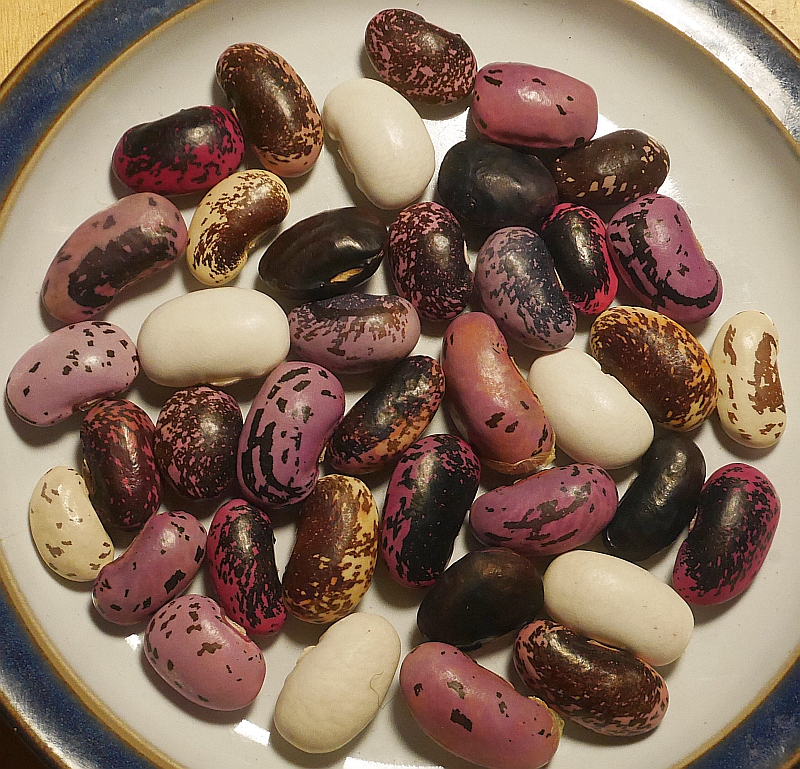
As with my broad bean grex, I will select for earliness and diversity of colour.
These varieties were used:
Polestar (Chiltern Seeds)
Celebration (Chiltern Seeds)
Jackpot (Chiltern Seeds)
Sunset
Ruusupapu (Finland)
Hammond’s Dwarf Scarlet
Preisewinner (PHAS 8592/ German) IPK Gatersleben
Bicolor (PHAS 212/ Slovakia) IPK Gatersleben
(PHAS 8106/ German) IPK Gatersleben
(PHAS 8158/ Slovakia) IPK Gatersleben
Albiflorus (PHAS 8121) IPK Gatersleben
Stengebohnen (PHAS 8143/ Netherlands) IPK Gatersleben
Albiflorus (PHAS 8117/ German) IPK Gatersleben
(PHAS 8124/ Austrian) IPK Gatersleben
Autumn Olives
The 3 autumn olive / Japansk sølvbusk (Elaeagnus umbellata) bushes at the Væres Venner Community Garden are now producing well. This is about 2/3 of the berries and I hope to harvest the remainder tomorrow. Apart from a few Aronia and Worcesterberries and apples we are near the end of the fresh fruit / berry harvest. See also my blog post “Late Fresh Berries” here: https://www.edimentals.com/blog/?p=29619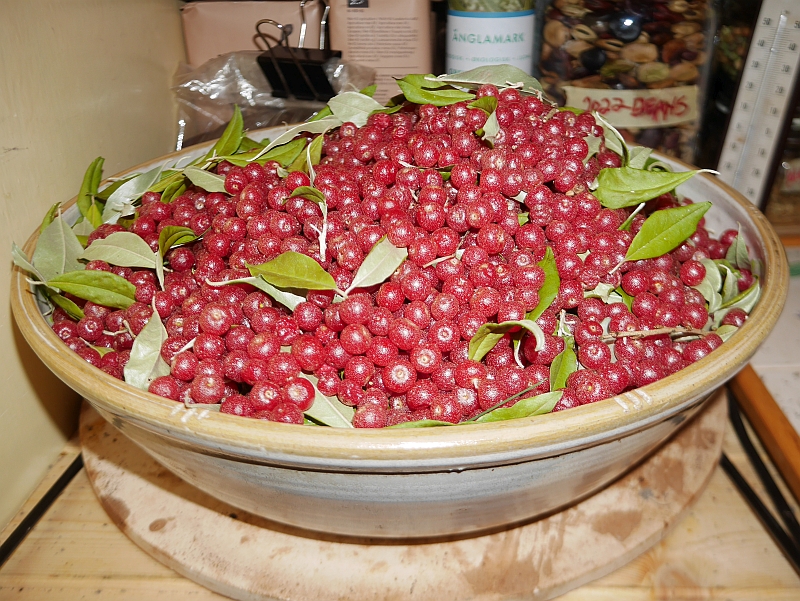 …and two pictures of the final fruit leather. Like sour cherries, they become sweeter on drying. Delicious!
…and two pictures of the final fruit leather. Like sour cherries, they become sweeter on drying. Delicious!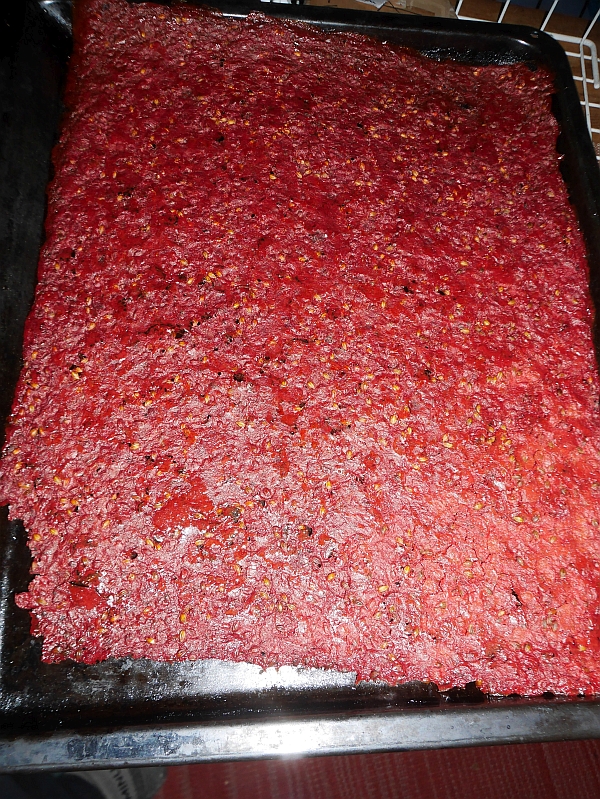

Pea harvest 2023
The garden pea / ert (now Lathyrus oleraceus, was Pisum sativum) is an important source of vegetable protein and can be grown over most of Norway with many heirloom varieties which have been rescued and are maintained across Scandinavia by seed saver organisations such as our own KVANN (Norwegian Seed Savers; kvann.no).
Over the years, I’ve grown over 90 different varieties and usually some 20 varieties every year, a mix of Scandinavian and UK heirlooms and modern varieities. There are some favourite varieties such as Golden Sweet, Purple Podded, Salmon Flowered, Sugar Snap and Hurst Green Shaft which I grow each year, whilst others are grown less frequently on a roughly 3 year rotation, so that I am maintaining some 40-50 varieties at any one time! I share a few with members of KVANN each year.
The pea harvest and processing for 2023 was completed yesterday: dried first on window sills, then sorted, saving the best peas for seed for the next grow-out and for sharing. I use the remainder mainly for pea soup, pea fritters/felafel and for sprouting for pea shoots. Here’s this year’s pea diversity shown in the pictures:
Outer ring: Rättviksärt, Mammoth Melting, Big Jumps / Karina, Sugar Magnolia, PI203064 Finsk (gift, rematriated from Seed Savers Exchange), Jærert, Lollandske Rosiner, Herald/Herault, (Middle): Alma, Salmon Flowered, Purple Podded, Golden Sweet, Slikkert fra Våler, Store Holgers Kämpeart, Sugar Snap and Magnum Bonum (Not shown: Brunært fra Nakskov and Svartbjörsbyn).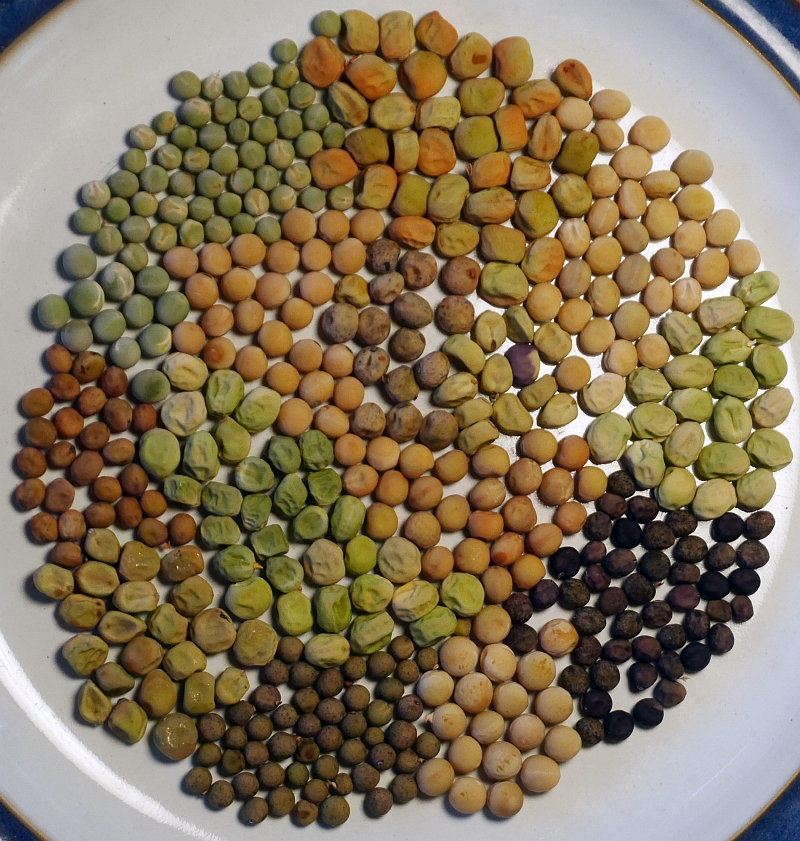

Norway Maple Fall
With cold nights down to -5C currently, most trees are now shedding their leaves and there’s a carpet of leaves under the Norway maple (spisslønn), a tree that prefers the shallow drier soils in the garden (compared to sycamore / platanlønn). A treecreeper (trekryper) calling can be heard at 0:38! The large leaves are very useful for protecting less hardy plants in winter.

